Don't Like the Climate? Wait a Cycle! |
I’ve wanted for some time to attempt to show the correlation between temperature, rainfall, and the economy. It’s something that became obvious to me some four years ago when I saw a chart of the number of tornadoes in the US, which spiked tremendously in 1974, the bottom of the economic recession is the 1970s. You can find that story (and the chart) here.
The lifelong work of Dr. Raymond Wheeler, which wasn’t mainstream (the problem with science these days), was difficult to find, but the corroborating evidence, mainly from the work of astrophysicists and other researchers of the Universe (like Steve Puetz), has become easier and easier to find, once you know where to look (but I’ll leave the astronomical causes—and biological effects—for another video).
The bottom line is that climate is cyclical … like just about anything else in the Universe. Cycles are in everything. In fact, I challenge anyone to find a straight line that exists naturally (they seem to come from the minds of economists, as far as I can make out).
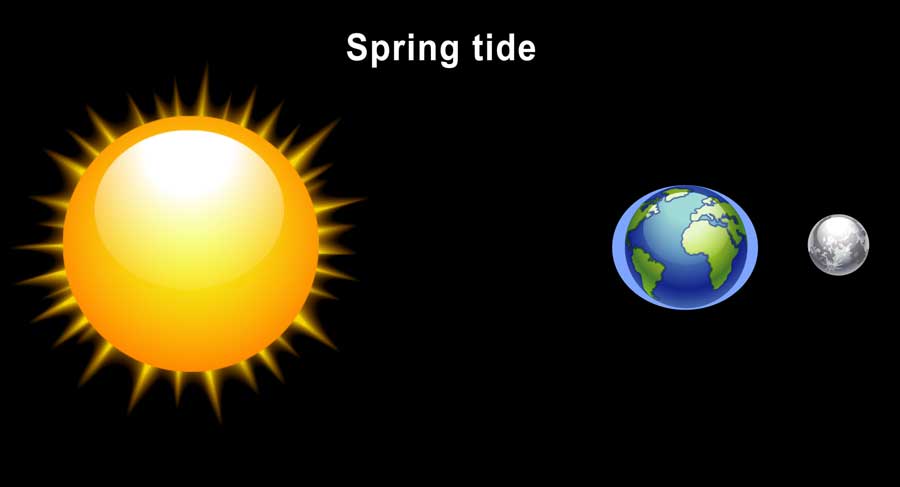 My example of tides (above) in the video is for the purpose of showing the strength of everyday cycles that we tend to take for granted. Tides are an effect of a tiny body of matter (the Moon), when we have much larger planets spinning around us (in cycle-time-periods that show up as cycles on Earth over and over again). Tides are caused by gravitational pull, but there are also electromagnetic waves (another video to come) that emanate from the same extraterrestrial bodies and the science tells us have enormous effects on life on Earth.
My example of tides (above) in the video is for the purpose of showing the strength of everyday cycles that we tend to take for granted. Tides are an effect of a tiny body of matter (the Moon), when we have much larger planets spinning around us (in cycle-time-periods that show up as cycles on Earth over and over again). Tides are caused by gravitational pull, but there are also electromagnetic waves (another video to come) that emanate from the same extraterrestrial bodies and the science tells us have enormous effects on life on Earth.
My attempts to simplify the explanation, however, can gloss over the actual complexity of all the forces at work.
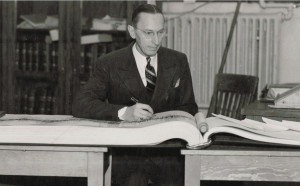 Dr. Wheeler spent his entire life analyzing weather cycles back over 20 centuries to 600 BC. He found that major climate cycles changed every 25, 100, 500, and 1000 years and that they’re fractal, which means there are smaller cycles within larger cycles.
Dr. Wheeler spent his entire life analyzing weather cycles back over 20 centuries to 600 BC. He found that major climate cycles changed every 25, 100, 500, and 1000 years and that they’re fractal, which means there are smaller cycles within larger cycles.
During his life, he put together an archive of world events relative to changes in climate that was some 2000 pages in length, and when open, spanned a length of some 7 feet. To the left is the only shot I’ve found of him working on “The Big Book.”
Here are the four twenty-five year cycles:
- Spring: warm and wet
- Summer, warm and dry
- Fall: cool and wet
- Winter: cold and dry.
Here’s the chart of the last century showing the DOW in relation to the fluctuating temperature and precipitation. Temperature and precipitation data come from National Oceanic and Atmospheric Administration (NOAA).
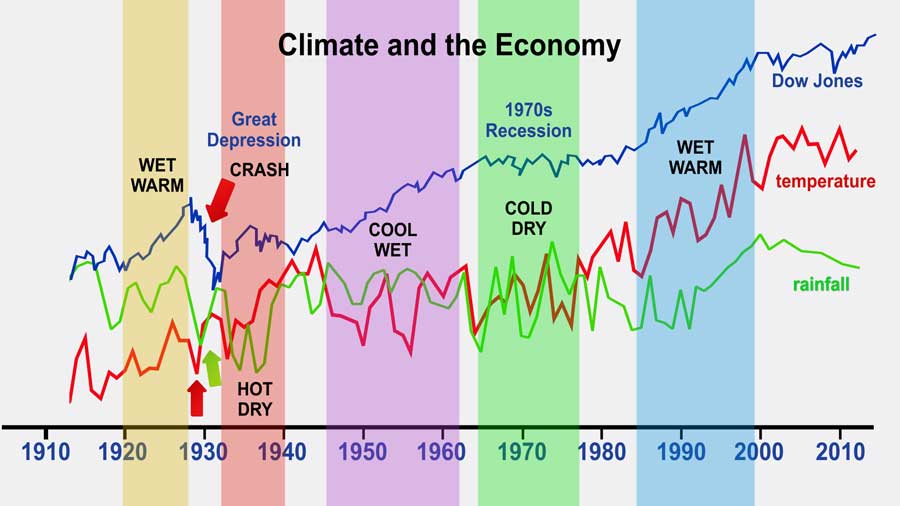
The roaring ’20s (yellow) were mostly wet and warm, but in 1929 (red arrow), it got very cold – the mercury plunged. Cold and dry has always led to tough economic times. The stock market crashed.
Then the next year, 1930 (green arrow points to temperature drop), was the driest year in over 150 years. It ushered in ten straight years of dry and hot (red)—about the hottest on record over the past couple of hundred years: The Great Depression. Hot and dry weather in history has led to a major war, despotism, dictators, socialism, communism, world wars, and other atrocities.
In the mid 40s (purple), it turned cool and wet … the economy picked up and the war ended. It lasted through to the ’60s—we had the Beatles, love and flowers … great times! Cool climate means energy–humans become much more active. Wet means prosperity in terms of food.
But in the late ’60s (green), we turned cold and dry … and that led to a deep recession that lasted through the late 70s. In fact there were articles in all the major newspapers predicting a mini ice age. Well, you’re likely to see those again.
But then it turned warm again in the ’80s (blue), the stock market turned up, and business started to boom! It was a warm-wet spring cycle once again—that means prosperity … and that lasted through the 90s, when it also started to get dry and cool again (after 1998).
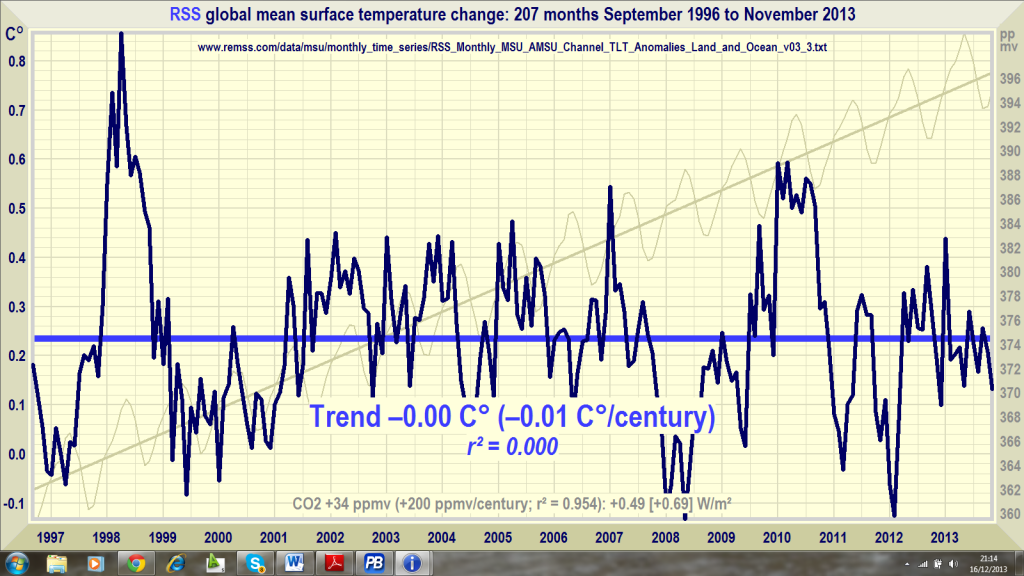
Here’s a chart of the temperature … flat … and starting to get cooler … and we all know how dry it is … look at California.
These climate cycles happen so regularly, that in the 1940s Dr. Wheeler predicted the current change in climate with his drought clock. And sure enough, in 1998, the temperature started to cool and we’ve been getting cooler and dyer ever since.
He also predicted extreme weather in the early twenty first century because we’re at the end of an even larger five hundred year cycle. Two major climate cycles are transitioning right now. That’s why we have such extreme weather.
Now, on a longer time frame, the Earth is cooling:
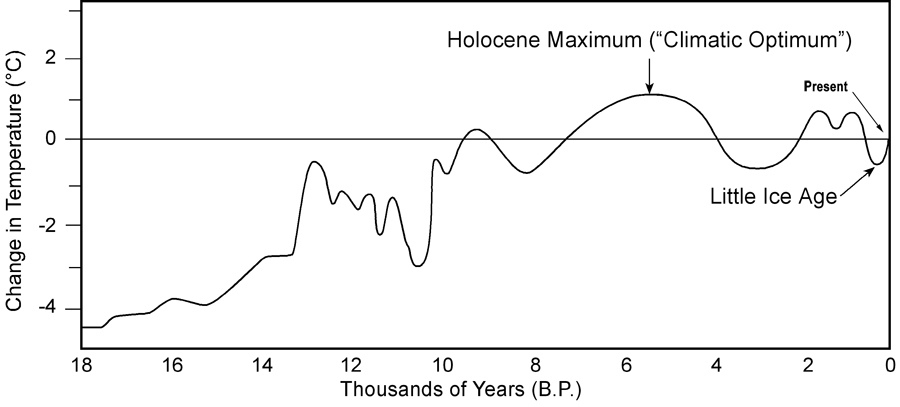
Source: J.A.Eddy, OIES, and R. S. Bradley, University of Massachusets, Earthquest, Spring 1991
As a trader, I always have to know the larger trend in order to understand the market direction and where it’s ultimately going. The anomalies in the climate that we’re seeing today are a very small fluctuation in a larger downtrend.
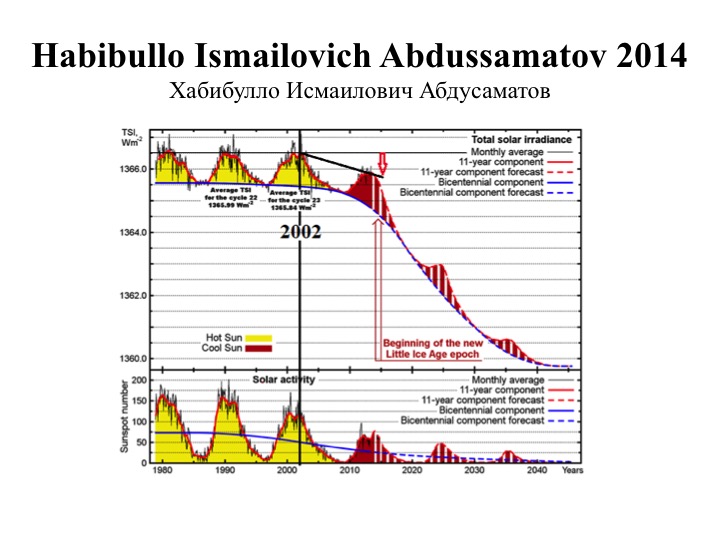
Habibullo Ismailovich Abdussamatov is the supervisor of the Astrometria project of the Russian section of the International Space Station and the head of Space research laboratory at the Saint Petersburg-based Pulkovo Observatory of the Russian Academy of Sciences. Most astrophysicists look at the Earth as a very small part of a larger formation: the solar system. Climate on Earth is primarily influenced by the Sun, which is influenced to some extent by the planets in our system.
We’ve already seen the lowest level of sunspots in the 2014 solar cycles maximum and he projects we’re headed for a mini ice age, due to the reduced solar irradiance in the forecast.
If you want more information on the bigger picture regarding climate and Earth and how it’s formed, I suggest you read “The Inconvenient Skeptic, by John Kehr. Hands down, this is the very best book I’ve read on climate for the layman (and I’ve read quite a few books on climate over the past few years!).
More on the Seasons and Dr. Wheeler’s findings:
The longer length “seasons” generally happen in the traditional order of the seasons we’re used to and are fractal. They change in 1000, 500, 100, and 25 year time periods. They aren’t exact in length, just like our annual seasons; they’re all slightly different, but the changes they bring to society have proven to be much the same over thousands of years.
Warm-wet (spring)
The warm-wet phase is the prosperous phase. There’s an outburst of nationalism and nation-building. There’s generally good to great leadership with strong governments that are initially democratic and benevolent. There’s also an expansion of trade and commerce a revival of learning, the appearances of great geniuses in philosophy, science, and the arts, and the rise of a new aristocracy.
Here are the “spring” trends:
- economic expansion
- cooperation, integrated efforts
- governments become inflexible and centralized
- bountiful crops
- enthusiasm
Warm-dry (summer)
People become lethargic (less active). Whole empires of animal life have died or greatly thinned out during hot/dry periods. There is usually a breakdown of the economic system at end of nation building period.
Here are the “summer” trends:
- Oppression
- Socialistic or communist trends
- Governments become reactionary and tyrannical.
- Public apathy.
- Civilizations become decadent
- Social control over the individual, oppression, rise in dictatorships
- In the 1930s, an epidemic of dictatorships broke out around the world
- Fanaticism
- Persecution of minorities
- Nationalistic movements
- Birth rate decline
- Health issues
Cool-wet (autumn/fall)
Cool-wet stages often become the “golden ages of history.” In the hands of a new generation, a fresh natural spirit wells up, and revolts occur against frustration. Enthusiasm, optimism, and aggressiveness, organized through a social revolution, result in a new state. Cool climate means human energy and it’s coupled (in this case) with an abundance of crops. The 50s and 60s were a cool-wet period and many today reminisce about that era.
Here’s a list of the key traits of a “fall” seasonal period:
- Cultural achievement
- Prosperity
- Best leadership
- High birth rates
- Individualism
- Mental vigor
- Intercultural exchange
Cold-dry (winter)
The cold-dry phase (the “season” we’re entering now) is marked by major geophysical phenomena, including] an increase in the severity of earthquakes and volcanoes… a lowering of continental altitudes, with marine invasions on the upswings and mountain building on the downswings.”
Weather is coldest during the cold-dry phase. Near the end of the cold-dry phase, societies become stabilized by strong leadership, reformed governments, and a revival of nationalism. The wars in this phase are expansionary and imperialistic, but not international world wars.
Here’s a list of the key traits of a “winter” seasonal period:
- Anarchism
- Depression
- Collapse of individualistic economy
- Period of inadequate government
- Trend towards anarchy and chaos
- Civil wars rather than international wars
- Mass migration
- Pandemics
Wheeler: “The cold phases of the cycles are dominated by various kinds of civil strife—civil wars, class struggles, between rich and poor and between conservatives and liberals, religious wars, democratic reforms, emancipations, broadening of franchise, colonization, migration, and piracy”—p 129, Climate: the Key to Understanding Business Cycles, Zahorchak.
This is a time of weak governments and generally, but not always, of poor leadership.
The best periods are the transition from cold to warm – the “Golden Ages” of history. The transition from the cold-dry to the following warm-wet period is characterized by a revival of learning, burgeoning genius, industrial revolution, and bountiful crops. Human behavior is improved by the high energy level (a trait of cool weather).
In each 100 year cycle, we alternate from prosperity to depression and back again twice. This can be traced back through twenty-seven cycles to 600 BC.
A note on the 500 year cycle – Wheeler stated in 1951 that “the next five hundred years will belong to Asia” He expected the turn in climate around the year 2000. Every five hundred years, there is a shift of power for East to West and vice versa. We can see this shift beginning to happen now.
Summary
Cool and dry is winter … it means civil wars, revolution, migration, riots, class struggles between rich and poor … society changes … with the weather … always has, always will.
But the good news is that if you’re prepared, it’s a fabulous time to be alive. Great opportunities came from the 30s … they’ll come from the next ten years. We’ll have a revolution around the world but end up with more democracy, romance, simpler lifestyles, and change for the better we can’t even imagine.
Climate is cyclical. Don’t like the weather? Wait a few decades. And in the meantime, read some history.
| “Those who cannot remember the past are condemned to repeat it.” |
| George Santayana, The Life of Reason or The Phases of Human Progress |




interesting insight…well done!
Thanks! I did this about a year and a half ago. I should re-cycle a lot of my past videos, I think. I have some new ones in the works, as well.
Excellent!
Thks, Verne.
You make it so clear, world events should almost be seen as a spectator sport, stand back and watch everything repeat it,s self. Reminds me of the Frank Sinatra song where he sings about being in the September of his life!
I,m in the September of my life but wish to capitalize on the global cooling. I,m thinking Greenhouse manufacturing!
Whats your take Peter?
Stephen,
I’m not sure what the question is, or what you mean by greenhouse manufacturing.
I have a simple question as it relates to your video.
Never before in the history of the earth has there been so many airplanes in the sky at one time and it is getting more every day, each plane is dumping exhaust in the atmosphere every second, or is that a minuscule amount in relation to the solar system.
for an example, I refer to ” planefinder.net “.
I live in Minnesota so I experience the Ice Age every winter.
Thank You,
Vincent L. Hendren
Vincent,
I’m not sure what the question is. Is this a concern about pollution? Plane exhaust doesn’t have anything to do with climate. In terms of ice ages, you’re going to get a mini one coming up. It’s starting to get much colder and dryer. It will gradually get colder now for the next hundred years, or so, at least.
Absolutely fascinating. I am running out of ink printing so much of the material to which you have directed me.
Would you recommend a short list of books, Wheeler and other, I might purchase leading to my education in the “cycles”. I say short list as I am 83 years old.
Thanks.
Hi Greg,
Here’s the book list: https://worldcyclesinstitute.com/books/
I have a couple of books visuals to replace today (Amazon) but otherwise, clicking on a book visual in the list takes you to the appropriate Amazon page.
Peter
just wondering when we can expect “normal” winter temperatures again in Northern New Mexico… we’re having days in February that are 15degrees above the high average and 38 degrees above the low average… Next year ? year after ?
thanks/w
Dr. Wheeler clocked the shorter cusp cycles at roughly 25 years, but they can extend longer. It’s like a larger degree fall cycle, and I would expect the volatility will go on for a at least a couple more years, I think. Then it should turn colder gradually. He also expected the major turn just before the year 2000, and it appears it was in 1998.
In Calgary, Alberta, we had about 10 days of extreme cold this winter, down to close to -35 C (a max for us). And now, it’s milder than usual. We’re seeing a day of 10 C coming this week (about 50 F).
Seems like you would be in great company with Dewey & Dakin
Love the work, and there is still so much to be done. Too bad most of the financial world uses this knowledge for questionable means, while it’s impact on academia is minuscule
On a similar vein of research, an RCA engineer in the early 20th century (Nelson was his last name I believe), found that radio interference was directly related to the sun’s activity. His later research indicated that reoccurring geometries in planetary alignments heavily influenced sunspot/coronal hole activity.
If only there was a standard model of cycles…
Cheers!
Perry,
There is a standard model for cycles. Dewey & Dakin did the preliminary work. Dr. Wheeler went much further and I’ve now aligned some of his cycles with conjunctions. 172 years is the Uranus/Neptune conjunction, for example. Steve Puetz took Wheeler’s work even further in his book, The Unified Cycle Theory. The major cycles are harmonic, and for the book I’m working on, and in many of my videos, I consider the key cycles to be (roughly) 7, 18.5, 57, 172, 515, 1030 years. There are also additional climate cycles of 25 and 100 years. And, of course, the solar cycle. There are many more, of course, but I consider them relatively minor. I go through some of the basics in my recent webinar: https://worldcyclesinstitute.com/thrive-in-the-new-economy-webinar-replay/